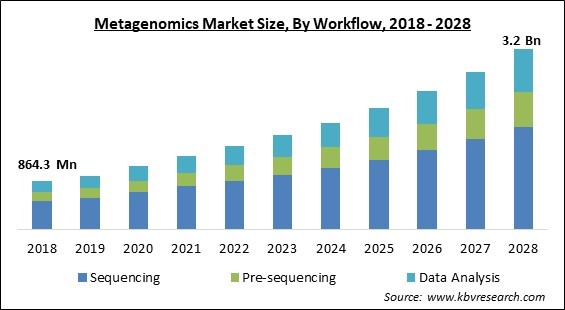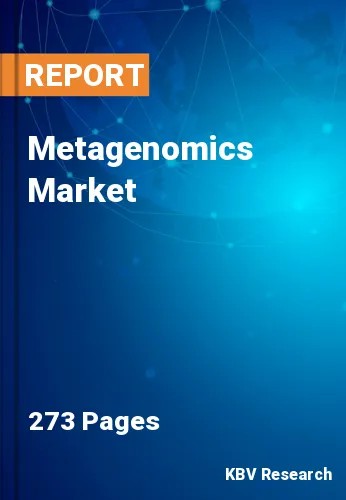The Global Metagenomics Market size is expected to reach $3.2 billion by 2028, rising at a market growth of 13.6% CAGR during the forecast period.
The study of genetic material extracted directly from samples collected is known as metagenomics. This expansive field is also known as environmental genomics, ecogenomics, and community genomics. While conventional microbiology, microbial genome sequencing, and genomics rely on produced clonal cultures, the early environmental genetic analysis relied on cloning certain genes (typically the 16S rRNA gene) to generate a profile of variety in a wild sample.

It demonstrated that cultivation-based approaches have missed the large bulk of microbial biodiversity. Metagenomics has the potential to transform knowledge of the whole living universe as a result of its ability to uncover the hitherto hidden diversity of microorganisms. As the cost of DNA sequencing continues to decline, metagenomics now enables the investigation of microbial ecology on a much larger scale and in greater depth than ever before.
Recent studies use "shotgun" or PCR-directed sequencing to obtain largely unbiased samples of all genes from all sampled community members. The term metagenome referred to the concept that a collection of sequenced environmental genes might be studied similarly to a single genome. As a source of DNA, conventional sequencing begins with a culture of identical cells. However, early metagenomic investigations indicated that broad groups of microbes in several habitats could not be cultivated and hence cannot be sequenced.
Multiple 16S rRNA sequences that do not correspond to any known cultured species have been discovered, indicating the existence of numerous non-isolated organisms. These surveys of ribosomal RNA genes extracted directly from the environment demonstrated that cultivation-based approaches detect less than one percent of the bacterial and archaeal organisms in a sample. The discovery that the great majority of microorganisms were previously unrecognized is largely responsible for the growing popularity of metagenomics.
Since the emergence of COVID-19, important players in the life sciences and biotechnology industries have sought solutions for COVID-19 tracking, diagnosis, and treatment. The analysis of metagenomics is vital for the discovery and tracking of the virus. Diverse sequencing monitoring solutions and platforms are being implemented for efficient infection diagnosis. In May 2021, for instance, Oxford University and Oracle established strategic cooperation to develop a robust cloud-based genomic sequencing and analysis platform to reduce the risk of coronavirus infection. Due to the exceptional demand for COVID-19 medication and vaccine discovery, economic activity in the metagenomics market is accelerating.
Continuous technological advancements in sequencing techniques have enabled the development of efficient, portable, and user-friendly NGS platforms that are capable of delivering speedy and accurate results and have a reduced turnaround time. The introduction of such products and technology offers players an immediate competitive advantage; hence, leading companies are investing more in R&D to increase their market positions and shares. Many new bioinformatics tools have been added to the metagenomics market as a result of technical improvements, which have increased the market's revenue.
The amount of data generated during whole-genome sequencing is often at the terabyte level. For end-users of NGS-based metagenomic sequencing, data management is a significant challenge. Due to differences in data formats and the lack of an industry-wide standard for data output from different NGS platforms, data storage requirements can be rather complex. The application of big data technologies and AI for NGS analysis and workflow management has considerably boosted the yield of NGS runs. With developments in sequencing technology, the quantity of data collected during a sequencing run likewise grows.
Academic research and development are almost entirely reliant on financial support from other sources in nations that are still considered to be developing. NGS sequencers continue to be prohibitively costly even though the cost of NGS sequencing has come down. The NovaSeq 5000 and 6000 are Illumina's two most sophisticated sequencing systems, and their prices range from hundreds to tens of thousands of US dollars.

Based on the Product, the Metagenomics Market is segmented into Kits & Reagents, Sequencing & Data Analytics Services, and Software. The kits & reagents segment acquired the highest revenue share in the metagenomics market in 2021. It is because, during the experimental sample preparation phase of sequencing, a variety of chemicals are utilized. Established firms such as F. Hoffmann-La Roche Ltd, Thermo Fisher Scientific, and Illumina Inc. offer an extensive selection of reagents to meet the needs of sequencing.
On the basis of Technology, the Metagenomics Market is divided into Shotgun Sequencing, 16S Sequencing, Whole Genome Sequencing, and Others. The whole genome sequencing segment recorded a substantial revenue share in the metagenomics market in 2021. Whole genome sequencing, also known as whole genome sequencing, complete genome sequencing, and entire genome sequencing, is the method of determining all or almost all of the DNA sequences of an organism's genome at once.
By Workflow, the Metagenomics Market is classified into Pre-sequencing, Sequencing, and Data Analysis. The pre-sequencing segment registered a significant revenue share in the metagenomics market in 2021. Pre-sequencing considerations include a selection of library size, read duration and type (single or paired-end), and sequencing depth. Post-sequencing decisions consist of choosing pre-processing stages, a reference library, and a mapping technique.
Based on the Application, the Metagenomics Market is bifurcated into Environmental, Clinical Diagnostics, Drug Discovery, Biotechnology, Food & Nutrition, and Others. The environmental segment acquired the largest revenue share in the metagenomics market in 2021. The space for metagenomics research in agriculture and environmental protection is expanding fast. Metagenomics is a novel approach to comprehending microorganisms from a certain environment by sequencing analysis or gene screening.
| Report Attribute | Details |
|---|---|
| Market size value in 2021 | USD 1.3 Billion |
| Market size forecast in 2028 | USD 3.2 Billion |
| Base Year | 2021 |
| Historical Period | 2018 to 2020 |
| Forecast Period | 2022 to 2028 |
| Revenue Growth Rate | CAGR of 13.6% from 2022 to 2028 |
| Number of Pages | 273 |
| Number of Tables | 479 |
| Report coverage | Market Trends, Revenue Estimation and Forecast, Segmentation Analysis, Regional and Country Breakdown, Companies Strategic Developments, Company Profiling |
| Segments covered | Workflow, Product, Technology, Application, Region |
| Country scope | US, Canada, Mexico, Germany, UK, France, Russia, Spain, Italy, China, Japan, India, South Korea, Singapore, Malaysia, Brazil, Argentina, UAE, Saudi Arabia, South Africa, Nigeria |
| Growth Drivers |
|
| Restraints |
|
Region-wise, the Metagenomics Market is analyzed across North America, Europe, Asia Pacific, and LAMEA. The North America segment garnered the largest revenue share in the metagenomics market in 2021. This dominance can be attributed to the presence of major corporations in the region with increasing R&D funding and technological advances in sequencing. Collaboration between businesses and academic institutions is one of the region's most important business strategies.
Free Valuable Insights: Global Metagenomics Market size to reach USD 3.2 Billion by 2028
The market research report covers the analysis of key stake holders of the market. Key companies profiled in the report include Bio-Rad Laboratories, Inc., Illumina, Inc., PerkinElmer, Inc., Thermo Fisher Scientific, Inc., Novogene Co., Ltd., Promega Corporation, Qiagen N.V., Takara Bio, Inc. (Takara Holdings Inc.), Oxford Expression Technologies Ltd., and F. Hoffmann-La Roche Ltd.
By Workflow
By Product
By Technology
By Application
By Geography
The Metagenomics Market size is projected to reach USD 3.2 billion by 2028.
Constant Technological Advancements In NGS Platforms are driving the market in coming years, however, Constrained End-User Budgets In Developing Nations restraints the growth of the market.
Bio-Rad Laboratories, Inc., Illumina, Inc., PerkinElmer, Inc., Thermo Fisher Scientific, Inc., Novogene Co., Ltd., Promega Corporation, Qiagen N.V., Takara Bio, Inc. (Takara Holdings Inc.), Oxford Expression Technologies Ltd., and F. Hoffmann-La Roche Ltd.
The Sequencing segment acquired maximum revenue share in the Global Metagenomics Market by Workflow in 2021 thereby, achieving a market value of $1.8 billion by 2028.
The Shotgun Sequencing segment is leading the Global Metagenomics Market by Technology in 2021 thereby, achieving a market value of $1.3 billion by 2028.
The North America market dominated the Global Metagenomics Market by Region in 2021, and would continue to be a dominant market till 2028; thereby, achieving a market value of $1.5 billion by 2028.
Our team of dedicated experts can provide you with attractive expansion opportunities for your business.

